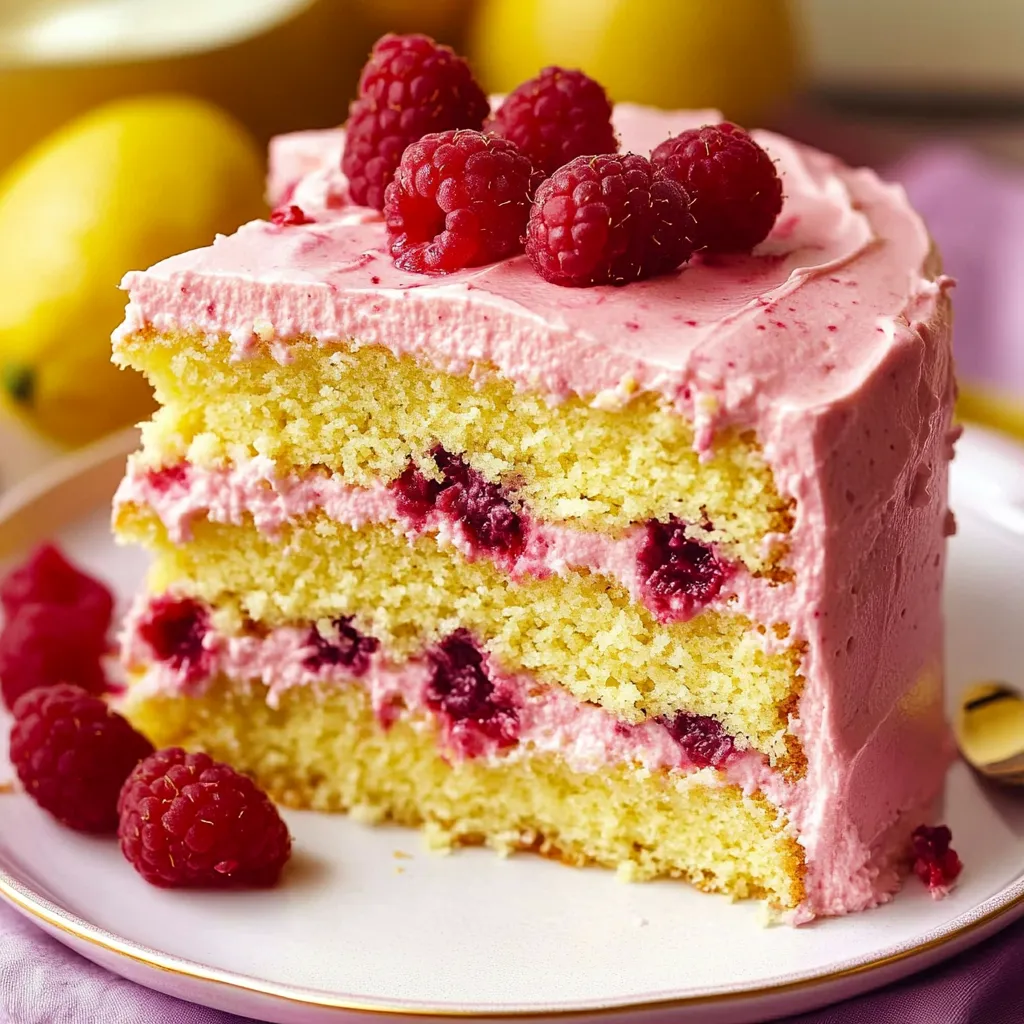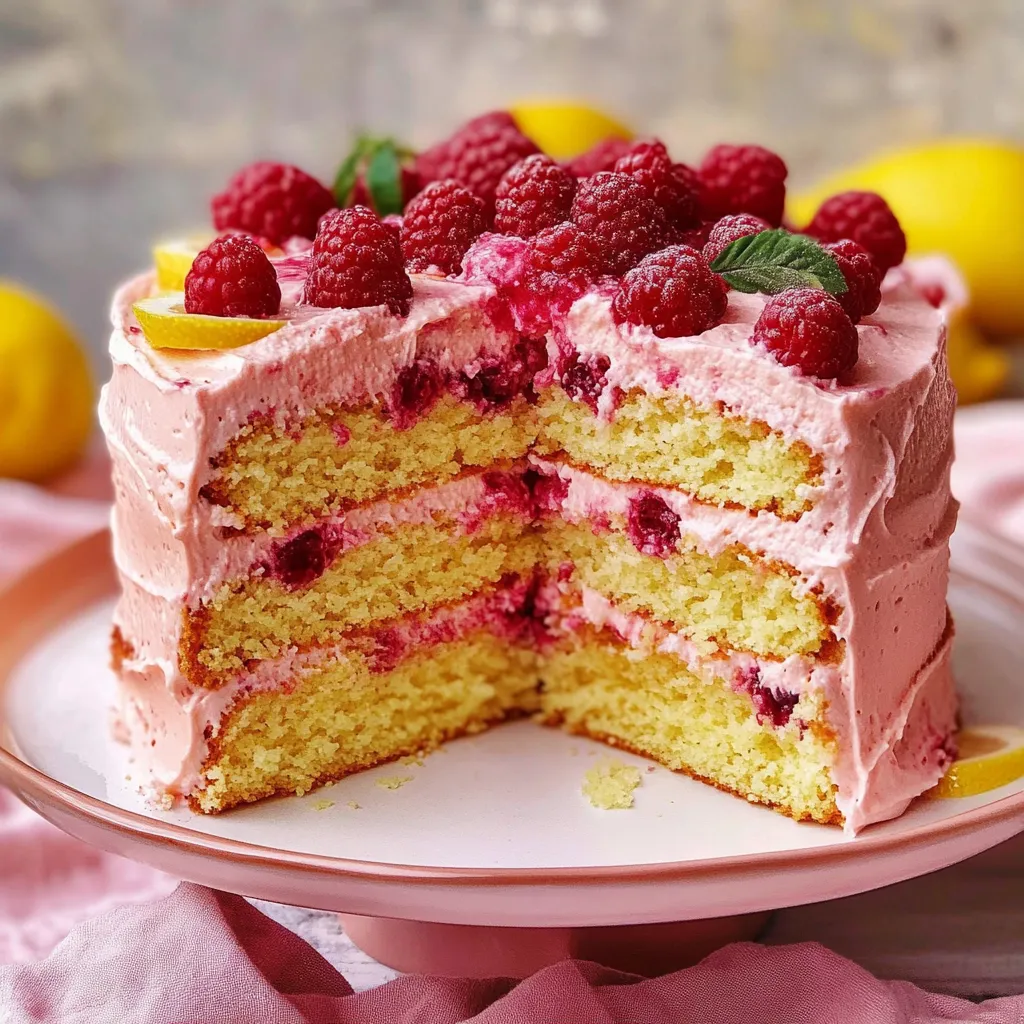 Pin it
Pin it
This bright lemon raspberry layer cake combines the tangy freshness of citrus with sweet-tart berries in every bite. Fresh raspberries get baked right into tender lemon butter cake layers, then the whole thing gets filled with raspberry-swirled whipped cream and covered in naturally pink raspberry buttercream. The gorgeous color comes entirely from real fruit - no artificial anything needed.
The first time I made this cake was for my daughter's summer birthday party, and I honestly wasn't sure the natural coloring would be vibrant enough. But when I pulled those cake layers from the oven dotted with jewel-like raspberries, and later swirled that gorgeous pink buttercream on top, I knew I'd never go back to artificial colors. My guests kept asking what made it so beautifully pink, and they were amazed when I told them it was just concentrated raspberries.
Essential Ingredients and Selection Tips
- Fresh raspberries: Choose firm, dry berries without any soft spots or mold; frozen raspberries release too much moisture and will make the cake soggy
- Quality butter: Use European-style unsalted butter with higher fat content for the richest flavor and best texture in both cake and frosting
- Fresh lemons: Zest the lemons before juicing them, and use a microplane grater to avoid the bitter white pith
- Heavy whipping cream: Must contain at least 35% fat content to whip properly; avoid ultra-pasteurized cream as it doesn't whip as well
- All-purpose flour: Measure correctly by spooning into the cup and leveling off, or better yet, use a kitchen scale for accuracy
- Room temperature eggs: Take them out 2 hours ahead or place in warm water for 15 minutes to ensure even mixing
Detailed Step-by-Step Instructions
- Start with the raspberry compote first:
- In a medium saucepan, combine 2 cups fresh raspberries, 1/3 cup granulated sugar, 2 tablespoons cornstarch, and 1 tablespoon fresh lemon juice. Cook over medium heat, stirring constantly, until the mixture begins to bubble and thicken, about 5-7 minutes. Use a wooden spoon to gently mash some of the berries while cooking, but leave some whole pieces for texture. The compote is ready when it coats the back of your spoon and holds its shape when you draw a line through it with your finger. Remove from heat, transfer to a bowl, and press plastic wrap directly onto the surface to prevent a skin from forming. Refrigerate for at least 1 hour until completely cool.
- Prepare your cake pans and oven properly:
- Preheat your oven to 350°F (175°C) and position the rack in the center. Butter two 9-inch round cake pans thoroughly, then line the bottoms with parchment paper circles. Dust with flour, tapping out any excess. This double protection ensures your cakes will release perfectly from the pans without sticking.
- Create the cake batter base:
- In a large mixing bowl, whisk together 1/2 cup melted butter (cooled to room temperature), 1/4 cup neutral oil, 1 1/3 cups granulated sugar, and the zest of 2 large lemons until the mixture looks fluffy and well combined. The key here is making sure your melted butter has cooled completely - hot butter will cook the eggs when you add them. Add 3 room-temperature eggs one at a time, whisking well after each addition until fully incorporated. Whisk in 1 teaspoon vanilla extract and 1/2 cup sour cream until the mixture is smooth and homogeneous.
- Combine and sift your dry ingredients:
- In a separate bowl, sift together 2 1/4 cups all-purpose flour, 2 1/2 teaspoons baking powder, 1/2 teaspoon baking soda, and 1 teaspoon salt. Sifting is crucial for this recipe since we're not using an electric mixer - it ensures all the leavening agents are evenly distributed and prevents lumps in your final batter.
- Master the mixing technique:
- Add the sifted dry ingredients to your wet ingredients and use a large spoon or rubber spatula to fold them together gently. When the mixture is about 80% combined with just a few streaks of flour remaining, add 3/4 cup whole milk in two additions, folding gently between each. Switch to a whisk for the final few strokes to create a smooth batter, but be careful not to overmix, which would develop the gluten and make your cake tough. Finally, fold in 1 1/2 cups fresh raspberries with the gentlest touch possible to avoid breaking them.
- Bake with precision:
- Divide the batter evenly between your prepared pans using a kitchen scale if you have one - each pan should get about 650 grams of batter. Bake for 28-32 minutes, rotating the pans halfway through for even browning. The cakes are done when they spring back lightly when touched in the center and a wooden skewer inserted in the middle comes out with just a few moist crumbs. Don't overbake - these cakes won't get very brown on top, just lightly golden.
- Cool completely before assembling:
- Let the cakes cool in their pans for 10 minutes, then run a knife around the edges and turn them out onto wire racks. Remove the parchment paper and let them cool completely to room temperature before frosting - this takes about 2 hours. Warm cake will melt your frosting and make assembly impossible.
- Make the raspberry cream filling:
- In a chilled bowl using chilled beaters, whip 1 1/2 cups heavy cream until soft peaks form. Add 3 tablespoons powdered sugar and 1 teaspoon lemon juice, then continue whipping until firm peaks form. Don't overwhip or you'll make butter. Gently fold in 1/3 cup of your cooled raspberry compote, leaving beautiful streaks throughout the cream.
- Create the raspberry buttercream:
- Make sure your butter is perfectly soft - it should give easily when pressed but not be melty. Beat 1 cup (2 sticks) soft unsalted butter with an electric mixer until light and fluffy, about 3-4 minutes. Gradually add 4 cups powdered sugar and 1 teaspoon vanilla, beating on low speed until incorporated, then increase speed and beat for 2 more minutes until pale and fluffy. Add 2-3 tablespoons heavy cream one tablespoon at a time until you reach the perfect spreading consistency. Finally, beat in the remaining raspberry compote on low speed just until combined - don't overbeat or the frosting may split from the fruit's moisture.
- Assemble like a professional:
- Place one cake layer on your serving plate and spread the raspberry cream filling evenly to the edges using an offset spatula. Top with the second layer, making sure it's aligned properly. Apply a thin crumb coat of frosting all over the cake, then refrigerate for 30 minutes to set. Apply the final layer of frosting, using long smooth strokes with your offset spatula to create beautiful swirls and swooshes on top.
 Pin it
Pin it
I learned the hard way that rushing the cooling process ruins everything about this cake. My first attempt was for a dinner party, and I was running behind schedule, so I tried to frost the cake while it was still slightly warm. The beautiful pink buttercream just melted right off the sides, and I had to scrape it all off and start over. Now I always make the compote and bake the cake layers the day before, then assemble everything the next morning when I'm not stressed about timing.
Understanding Cake Structure and Moisture
The secret to this cake's incredibly tender crumb lies in the combination of fats used. Butter provides unmatched flavor and helps create structure through its solid fat content, while a small amount of oil keeps the cake moist for days. Oil remains liquid at room temperature, which means cakes made with some oil stay softer longer than those made with butter alone. The sour cream adds both tanginess and additional moisture while contributing to the cake's fine, velvety texture through its acidity.
The Chemistry of Natural Food Coloring
Raspberries contain anthocyanins, which are water-soluble pigments that create those gorgeous red and purple colors. When you cook raspberries down into a compote, you're concentrating these natural pigments while also breaking down the cell walls to release more color. The slight acidity from lemon juice actually helps stabilize these pigments and prevents them from fading. This is why your frosting maintains its beautiful pink color even after sitting out, unlike some artificial colors that can fade or change under light.
Mastering Whipped Cream Consistency
Perfect whipped cream requires cold everything - cold cream, cold bowl, cold beaters. Heavy cream with 35% fat content whips up to about double its original volume when done correctly. The key is watching for the right stages: soft peaks bend over when you lift the beaters, while firm peaks hold their shape but still look smooth and glossy. Overwhipped cream becomes grainy and starts to separate, eventually turning into butter if you keep going.
Frosting Troubleshooting and Recovery
Buttercream can be temperamental when you add fruit purees because the water content can cause the emulsion to break. If your frosting looks curdled or separated after adding the raspberry compote, don't panic. Usually, you can save it by beating in an additional tablespoon of soft butter or a splash of heavy cream. The key is making sure your compote is completely cool before adding it, and beating it in gradually on low speed to maintain the emulsion.
Storage and Make-Ahead Strategies
This cake actually improves after sitting overnight, as the flavors meld together and the moisture from the filling and frosting creates an even more tender texture. Store it covered in the refrigerator, but bring it to room temperature before serving for the best flavor and texture. The raspberry compote can be made up to three days ahead, and the unfrosted cake layers can be wrapped tightly and frozen for up to a month.
After making this cake dozens of times for birthdays, potlucks, and special occasions, I've discovered that the most important factor is patience. Everything about this recipe rewards taking your time - from properly cooling each component to allowing the flavors to develop overnight. The payoff is a cake that looks like it came from a high-end bakery but tastes even better because it's made with real ingredients and genuine care. My neighbors have started requesting this specific cake for their celebrations, and I never get tired of seeing their faces light up when they take that first bite.
Frequently Asked Questions
- → Can I use frozen raspberries instead of fresh?
- Yes, frozen raspberries work great for the compote. Don't thaw them first - just add them straight to the pan. For the cake batter, fresh berries work better.
- → How long does this cake stay fresh?
- Store covered in the fridge for up to 4 days. The flavors actually get better after the first day as everything melds together.
- → Can I make this cake ahead of time?
- Absolutely! Bake the cake layers up to 2 days ahead and wrap well. The raspberry compote keeps for a week. Assemble the day you plan to serve.
- → What if my buttercream looks curdled after adding the compote?
- This happens when the compote is too cold. Let it come to room temperature and beat the frosting again. It should come back together smoothly.
- → Can I leave out the lemon zest?
- The lemon zest gives the cake its bright flavor, so I don't recommend skipping it. If you must, add an extra teaspoon of vanilla extract instead.
- → Do I need to remove the raspberry seeds from the compote?
- It's totally up to you! The seeds add nice texture, but you can strain them out through a fine mesh sieve if you prefer a smoother sauce.
